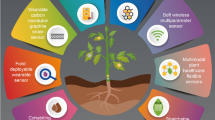Abstract
Technical advancements in the field of capacitive sensing and the availability of multi-channel capacitance-to-digital converters have led the way for improved sensing capabilities in the field of wood moisture content. A four-channel, planar capacitance sensor was developed and calibrated on maple veneers. The calibration material was conditioned to equilibrium at three different relative humidity levels. Optimal penetration depths were determined statistically and analytically. A rule of mixture approach and a volumetric model were applied to derive the moisture content at distinct layers. Different levels of discrepancy of the fit were observed among and within the different electrodes and calibration datasets. The sensor was able to determine changes in moisture content and positive moisture content gradients, rather than averages, with the limitation of detecting negative moisture gradients.














Similar content being viewed by others
References
Carlsson E, Gevorgian S (1999) Conformal mapping of the field and charge distributions in multilayered substrate CPWs. IEEE Trans Microw Theory Tech 47:1544–1552
Chen T, Bowler N (2010) Analysis of a concentric coplanar capacitive sensor for nondestructive evaluation of multi-layered dielectric structures. IEEE Trans Dielectr Electr Insul 17(4):1307–1318
Chetpattananondh P, Thongpull K, Chetpattananondh K (2017) Interdigital capacitance sensing of moisture content in rubber wood. Comput Electron Agric 142(Part B):545–551
Forsén H, Tarvainen V (2000) Accuracy and functionality of hand held wood moisture content meters. Technical Research Centre of Finland Espoo, Finland
Fuchs A, Moser MJ, Zangl H, Bretterklieber T (2009) Using capacitive sensing to determine the moisture content of wood pellets–investigations and application. Int J Smart Sens Intell Syst 2:293–308
Ihaka R, Gentleman R (1996) R: a language for data analysis and graphics. J Comput Graph Stat 5:299–314
James WL (1963) Electric moisture meters for wood. Department of Agriculture, Forest Service, Forest Products Laboratory, Madison
James WL (1975) Dielectric properties of wood and hardboard: variation with temperature, frequency, moisture content, and grain orientation (No. FSRP-FPL-245). Forest Products Lab Madison
James WL (1986) The interaction of electrode design and moisture gradients in dielectric measurements on wood. Wood Fiber Sci Number 2:264–275
Jazayeri S, Ahmet K (2000) Detection of transverse moisture gradients in timber by measurements of capacitance using a multiple-electrode arrangement. For Prod J 50:27–32
Li X, Zyuzin AS, Mamishev AV (2003) Measuring moisture content in cookies using dielectric spectroscopy. In: Conference on electrical insulation and dielectric phenomena, 2003. Annual report. IEEE, pp 459–62
Li X, Larson SD, Zyuzin AS, Mamishev AV (2006) Design principles for multichannel fringing electric field sensors. IEEE Sens J 6:434–440
Torgovnikov GI (1993) Dielectric Properties of Wood-Based Materials. Springer, Berlin, pp 135–159
Acknowledgements
This work was supported and funded through the National Science Foundation Industry/University Cooperative Research Center for Wood Based Composites award no. IIP-1624599. A special thanks goes to Milo Clauson, Senior Research Assistant in the Department of Wood Science and Engineering at Oregon State University, for his help and advice.
Author information
Authors and Affiliations
Corresponding author
Rights and permissions
About this article
Cite this article
Laleicke, P.F., Kamke, F.A. A capacitive multi-wavelength sensor for moisture content gradient sensing in wood. Wood Sci Technol 52, 717–732 (2018). https://doi.org/10.1007/s00226-018-0988-z
Received:
Published:
Issue Date:
DOI: https://doi.org/10.1007/s00226-018-0988-z




